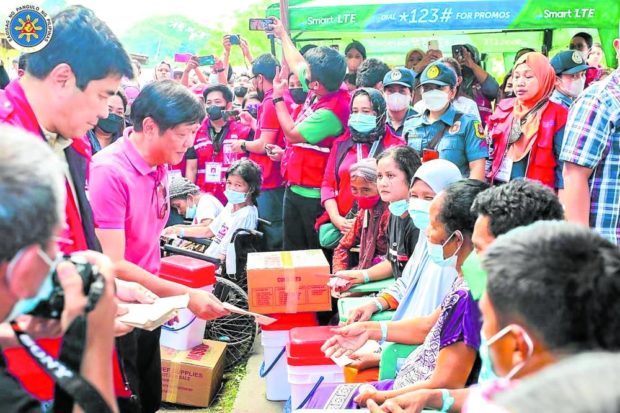Marcos at ground zero: Tree cutting to blame for landslides

RELIEF | President Ferdinand Marcos Jr. leads the distribution of relief assistance to Paeng victims taking shelter at Broce Central Elementary School of Peace at Datu Odin Sinsuat, Maguindanao province, on Tuesday. (Photo from Malacañang)
MANILA, Philippines — President Ferdinand Marcos Jr. on Monday said trees should be planted in the denuded uplands of the two Maguindanao provinces to prevent a repeat of last week’s deadly landslides after seeing for himself what environmentalists for years had been warning the government on what would happen not only in Mindanao but also in other parts of the country.
Marcos, accompanied by Maguindanao del Sur Gov. Bai Mariam Sangki-Mangudadatu, flew over the areas devastated by the landslides and flash floods that followed heavy rains brought by Severe Tropical Storm Paeng (international name: Nalgae).
“I was pointing out to the governor that in all those places where there are trees, the ground did not move. All the damage that you saw on the mountains, it’s because they were bald,” Marcos said.
“We know and we’ve been hearing this over and over again, but we continue cutting trees, so what happens are landslides like those,” he said.
After his aerial inspection, the president and his party landed at Datu Odin Sinsuat, capital of Maguindanao del Norte, where he met officials of the Bangsamoro Autonomous Region in Muslim Mindanao (BARMM).
Almost wiped off map
The town includes Barangay Kusiong, which was nearly wiped off the map by tons of mud, rocks, and boulders that came crashing down on the village on Friday last week.
The National Disaster Risk Reduction and Management Council (NDRRMC) reported on Tuesday that of 61 who died in the floods and landslides in BARMM, 42 were from Datu Odin Sinsuat.
Kusiong lies at the foot of the 446-meter Mt. Minandar.
Rescuers on Monday waded through thigh-deep mud in the village using long pieces of wood to search for bodies buried under the rubble.
Twelve of the dead in Kusiong, including seven from one family, were buried on Monday in two mass graves dug by a backhoe.
Mourners, who survived the landslide, laid flowers and candles at the site.
Flood control planning
“We have shifted our operation from search and rescue to retrieval because the chances of survival after two days are almost nil,” said BARMM Interior Minister Naguib Sinarimbo.
The President told officials of BARMM, which includes Maguindanao del Sur and Maguindanao del Norte, that tree planting should be included in their long-term flood control projects.
“If there had been trees up there, in Kusiong, that would not have happened,” Marcos said. “That’s unfortunate … I am very clear in my mind that that (tree planting) is something we could have done.”
He said he could refer them to “plenty” of nongovernmental organizations that could help in reforestation. He did not mention which groups.
He also did not say what measures would be taken to stop people from cutting down trees in fragile forests.
He said the Department of Environment and Natural Resources would also assist them in making tree planting sustainable, adding that during disasters, folks whose crops were destroyed would often resort to logging to make ends meet.
“The new way to do it is to make the locals themselves the owners of the trees so that they will take care of them,” he said.
‘Strange’
Reacting to the president’s remarks about the denuded forests, Jon Bonifacio, spokesperson for the environmental group Kalikasan, told the Inquirer that it was “strange that it seems like it’s only now he’s come to appreciate the benefits provided by well-conserved watersheds.”
“Let’s also not forget the massive deforestation that took place under his father’s rule,” he added.
Worsened under Marcos Sr.
“As Marcos Jr. just found out, environmental destruction has deadly consequences—and, if the government is serious at all about climate change, it needs to put a stop to the destructive mining, megadam and reclamation projects that are cutting down the very forests he’s worried about.” Bonifacio said.
In a column published by the Inquirer in 2011, former Kalikasan spokesperson Marjorie Pamintuan said that deforestation “further worsened” during the dictatorial regime of the President’s father and namesake.
“The logging industry was controlled by foreign companies and the local elite, some even holding public offices. Timber licensing agreements were given out by the Marcos regime to loyalists. From 1965 to 1986, the Philippines lost 7 million ha of forests,” she said.
She wrote the column six months before Severe Tropical Storm “Sendong” (international name: Washi) caused massive floods that rampaged through the cities of Cagayan de Oro and Iligan in December 2011, killing more than 1,000 people.
Due to deforestation and the large amount of rainfall then in the highlands of Bukidnon, the floodwaters easily rushed down to low-lying areas.
In December the following year, Typhoon “Pablo” (international name: Bopha) also caused deadly landslides in mountainous areas in Davao de Oro, which were blamed on mining and logging activities that denuded the once-forested slopes of the towns of New Bataan and Monkayo. Nearly 1,000 people died.
Better coordination
Aside from reforestation, the president also said the regional government should establish its own public works and highways district offices to quickly repair damaged infrastructure during calamities.
These offices should be on standby as damaged or destroyed bridges are the most difficult to repair but roads are easier to fix, he said.
The president raised the need for improved coordination between the BARMM regional government and its local governments units (LGUs) in times of disasters and emergencies.
“And then the [coordination] procedures. I know that you are just drawing up your procedures now, but you can see why this is so important,” he said.
The President said that he also noticed that the regional government and LGUs do not have joint operations, which could maximize the use of their assets.
“In BARMM areas or LGUs with bigger populations, you should join forces [with local leaders] so that we can maximize. The coordination [among yourselves] should be enhanced,” Marcos said.
—WITH REPORTS FROM MARIEJO S. RAMOS, KRIXIA SUBINGSUBING, FRANCES MANGOSING AND AGENCE FRANCE-PRESSE
RELATED STORIES
Direr Paeng picture forms: 112 dead, 161 calamity areas
Paeng displaces thousands of families in Calabarzon
Damage to farms, fisheries in Bicol due to ‘Paeng’ hits P701 million
Responding to appeals for help, the Inquirer is extending its relief efforts to the families affected by Typhoon Paeng. Cash donations may be deposited in the Inquirer Foundation Corp. Banco De Oro (BDO) Current Account No.: 007960018860 and through Maya
